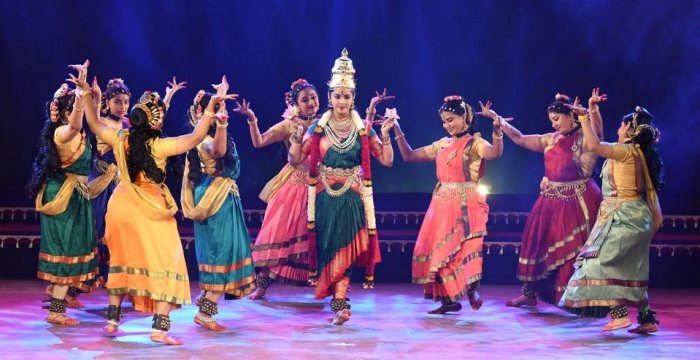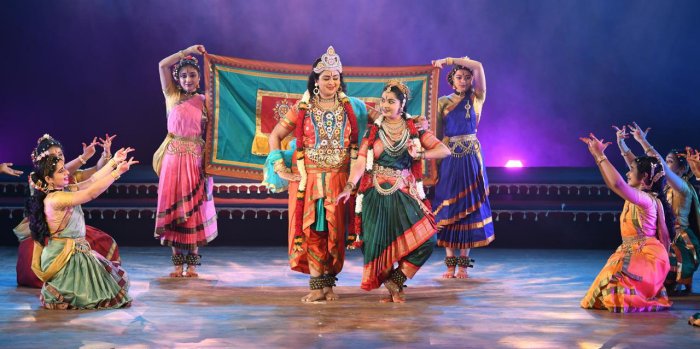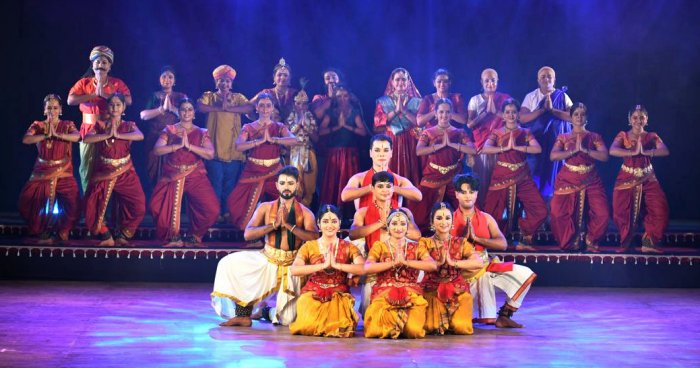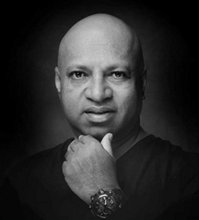
|   |

|   |
Natya Sangama - A tribute to Guru B. Bhanumati - Srivatsa Shandilya e-mail: vatsaphoto@gmail.com Photos: Madhusudan October 26, 2024 In a fitting tribute to the legendary Guru B. Bhanumati, the program Natya Sangama was a resplendent classical dance, presented by two of her senior disciples, Sheela Chandrashekhar, artistic director of Bhanumati Nritya Kala Mandiram, and Seetha Guruprasad, artistic director of Bharatanjali Natya Shaale. The title "Sangama" (meaning confluence) perfectly symbolized the union of two schools of dance, much like the meeting of the sacred rivers Ganga and Yamuna. This confluence not only enriched the performers but also the audience, offering a blend of knowledge, devotion, and artistic excellence.  Bharatanjali Natya Shaale The morning opened with Bharatanjali Natya Shaale's presentation of the dance drama "Shri Haripriya", a story of Goddess Lakshmi's emergence from the Ksheerasagara (ocean of milk) during the churning of the ocean, and her establishment in Karaveerapura (modern day Kolhapur). The performance began with a graceful invocation of Sriman Narayana and a beautiful rendition of the Lakshminarayana Stotra. The narrative showcased the dramatic episode of Samudra Manthana, vividly depicting the roles of Vasuki as the churning rope, the tortoise Koorma supporting the Mandara mountain, and Lord Shiva drinking the poison that emerged during the process. The depiction of these mythological events was done with finesse, seamlessly blending the spiritual with the artistic. The dancers brought out the grandeur of the churning with precision and clarity.  Bharatanjali Natya Shaale Particularly captivating was the depiction of Sri Lakshmi Devi's vivaha (marriage) to Sriman Narayana, symbolizing their inseparable bond. The emotive portrayal of her departure from Vaikuntha, following the insult of Narayana by Bhrugu Muni, and her ultimate arrival in Karaveerapura after defeating Kolhasura was both poignant and powerful. The dance drama concluded with the enchanting kriti "Jaya Kolhapura Nilaye", a fitting tribute to the Goddess in her Kolhapura abode, highlighting her as "Simhavahini" and "Gadadharini." The dance drama, conceptualized by Guru Seetha Guruprasad and accompanied by the music of Shrivatsa, was a well-rounded performance. The choreography, grounded in the Bhanumati style, excelled in storytelling through crisp movements and evocative expressions, demonstrating an adherence to classical grammar. The coordination between the dancers, especially in group formations, was seamless and elevated the visual storytelling to new heights. In the second half of the program, Bhanumati Nritya Kala Mandiram presented "Karunada Vaibhava", a tribute to Karnataka's eminent historical figures, combining devotion and valor through dance. The performance began with a serene Pushpanjali and concluded with an energetic Tillana.  Bhanumati Nritya Kala Mandiram The first character, Bibi Nachiyar, the daughter of a Delhi Sultan who, inspired by her friend Subhadra, becomes a devotee of Lord Krishna, was portrayed with grace and devotion. The transformation of Mumtaz into Nachiyar and her deep love for Krishna echoed the story of Meera, and the emotional depth in the dancer's portrayal was moving. The portrayal of Kitturu Rani Chennamma was a highlight. The heroic fight against British forces was depicted through dynamic and powerful movements, with the dancer embodying the fierce spirit of the warrior queen. The contrast between this and the gentle, witty character of Tenali Rama that followed was handled skillfully, bringing humor and lightness to the narrative. The next segment, Onake Obavva, showcased the valor of a simple housewife who courageously fought against Hyder Ali's army. The performance was gripping, and the audience could feel the tension as the dancer portrayed Obavva's bravery in the face of overwhelming odds. Finally, Shri Kanakadasaru's story brought the segment to a spiritual climax. His devotion to Lord Krishna, despite being ostracized by the orthodox, was portrayed with dignity and depth. The portrayal of Kanakadasaru's unwavering faith in Krishna and his eventual acceptance was both heartwarming and thought-provoking.  Bhanumati Nritya Kala Mandiram The second dance drama, choreographed by Guru Sheela Chandrashekhar, was equally captivating. The transitions between characters were smooth, and the entire performance was tied together with strong narrative coherence. The artistry and flexibility of the dancers were remarkable, especially in their ability to convey deep emotion through subtle movements and precise hand gestures. The music, once again composed by Shrivatsa, was a perfect complement to the dances, enhancing the drama and helping the dancers embody their characters. The use of instruments like the mridanga, flute, violin, and keyboard were thoughtful, with each instrument amplifying the emotional tone of the scenes. A special mention must go to Vani Raghavendra Kulkarni, whose anchoring provided clarity and depth to the performances, and to the lighting team, who enhanced the visual experience with their skillful manipulation of light and shadow. In summary, Natya Sangama was a fitting homage to Guru B. Bhanumati's legacy. Both dance dramas succeeded in presenting unique stories from mythology and history, while maintaining the high standards of classical art that Bhanumati was known for. The program beautifully captured the essence of two dance schools coming together to enrich the audience and honor the memory of their beloved Guru.  Srivatsa Shandilya is a photojournalist and director of International Arts & Cultural Foundation, Bengaluru. |